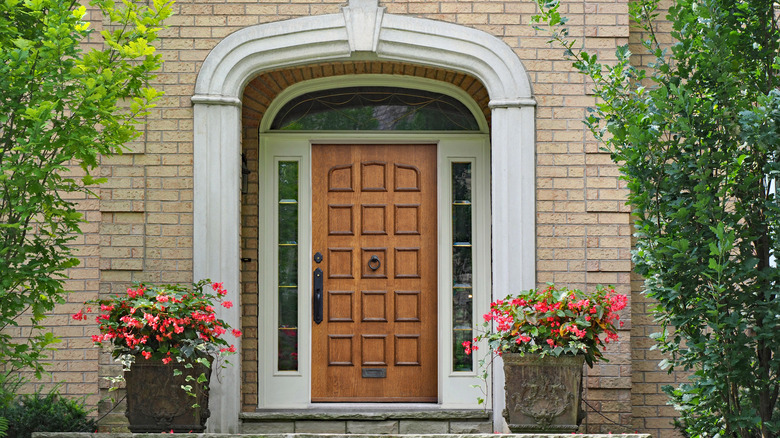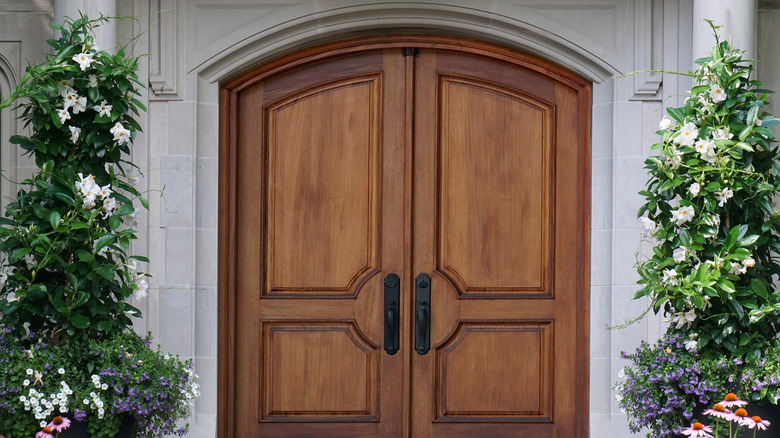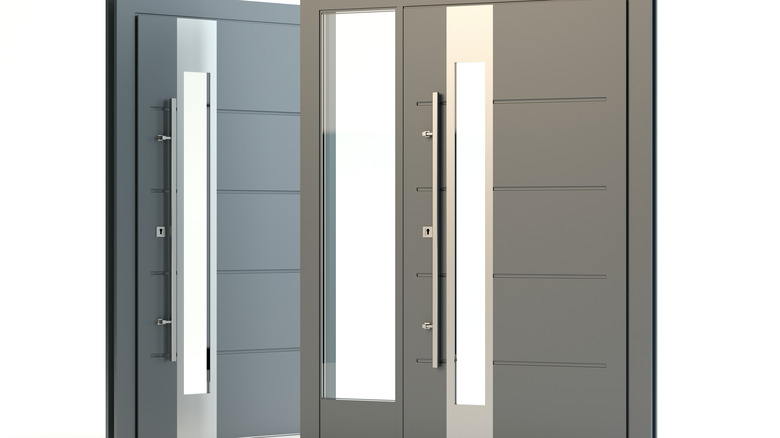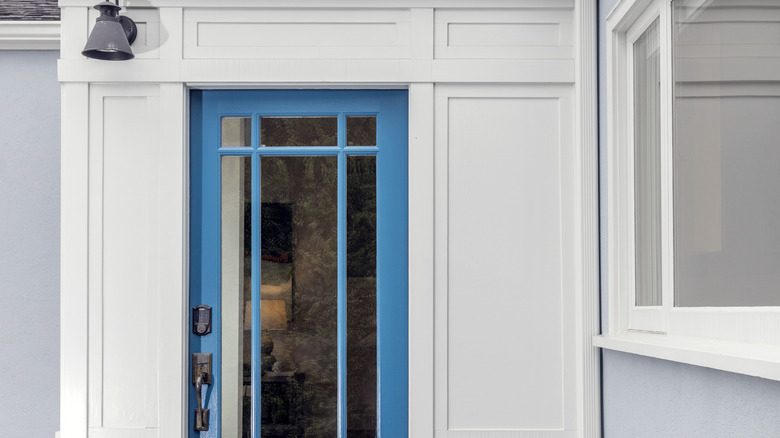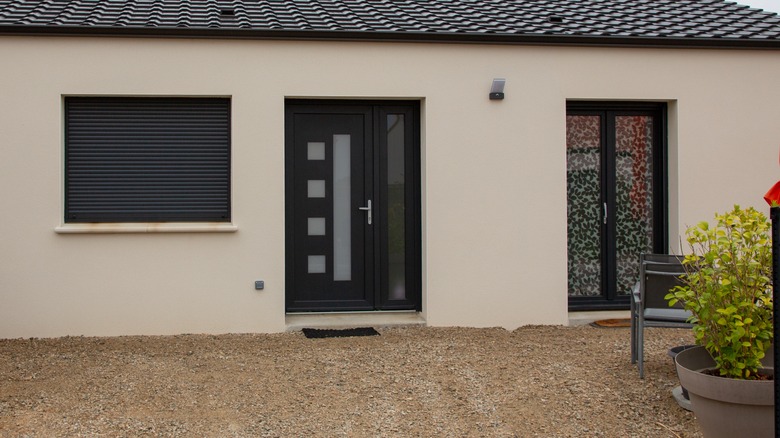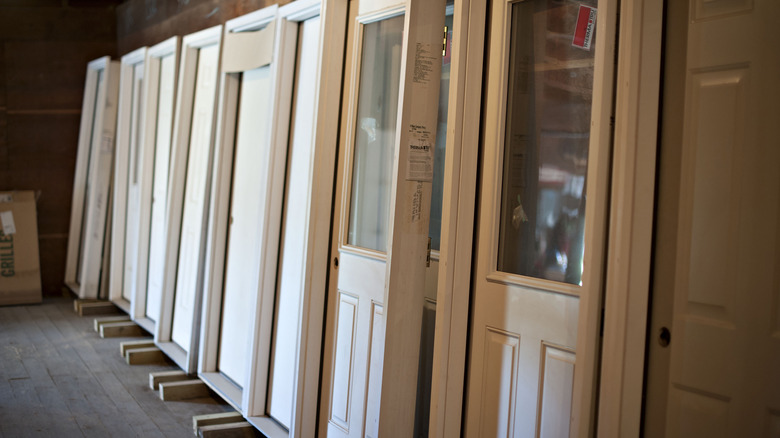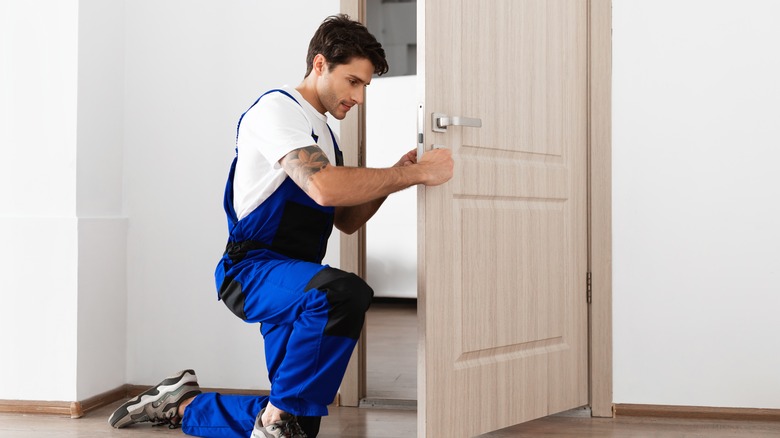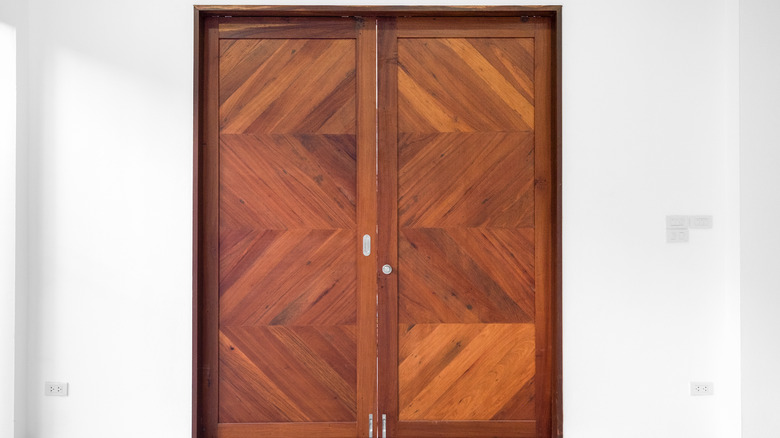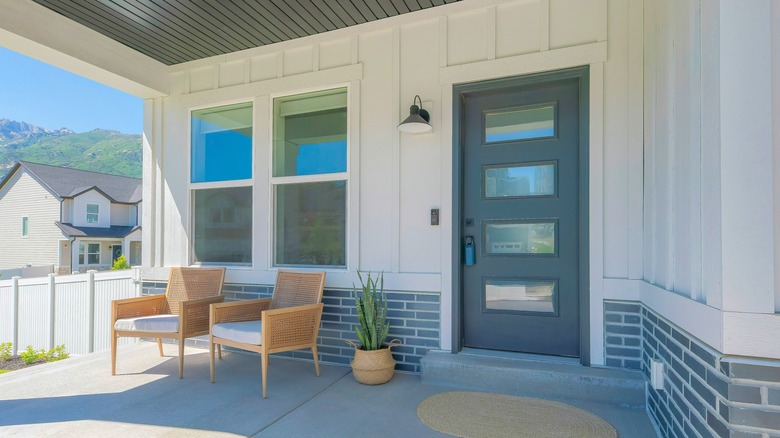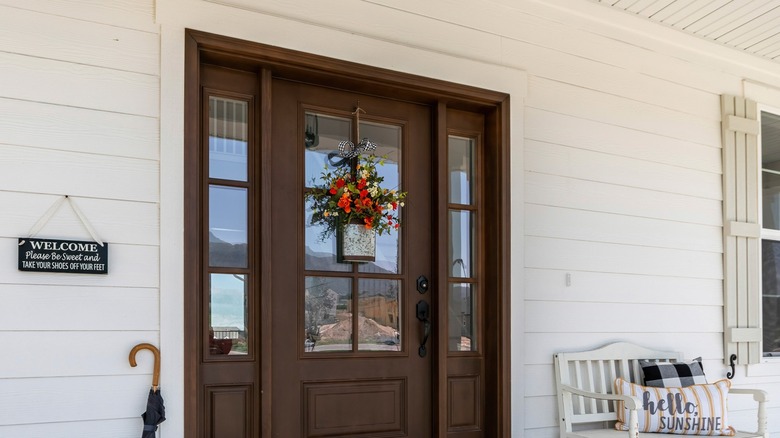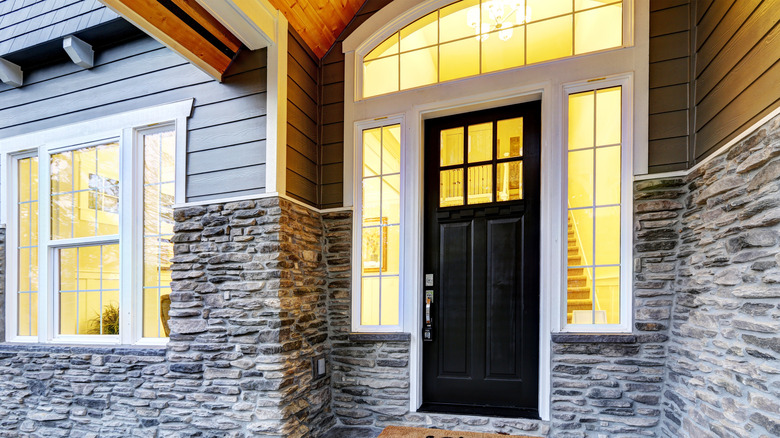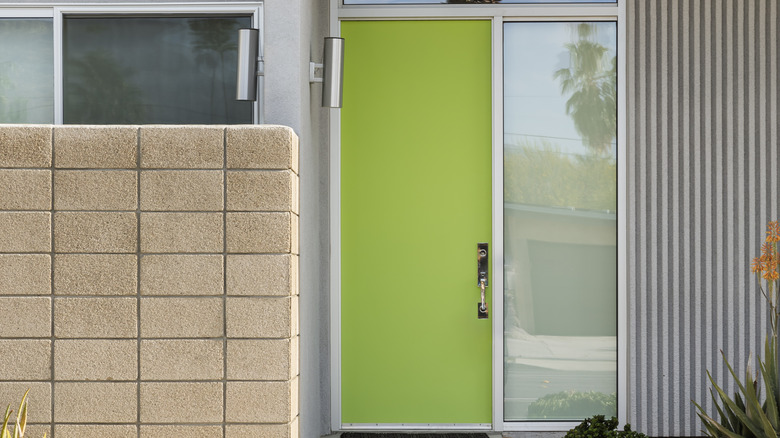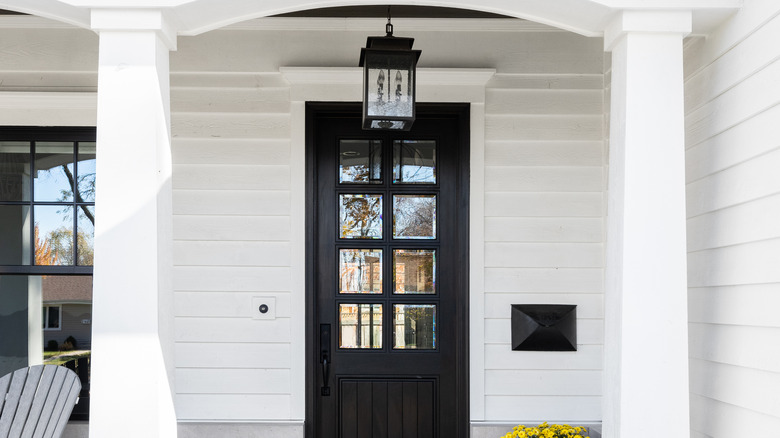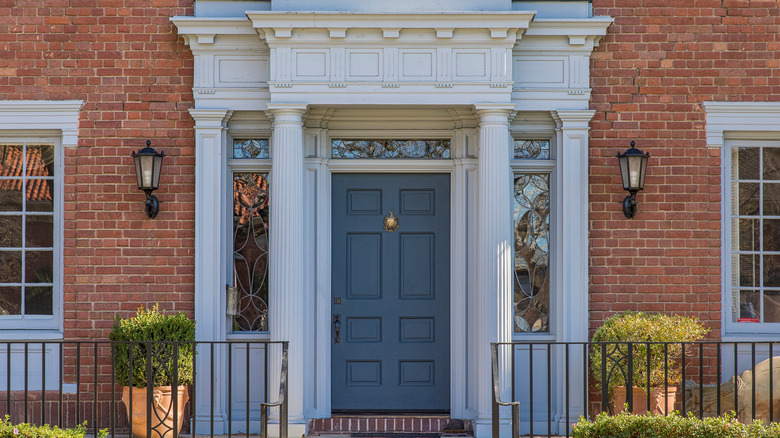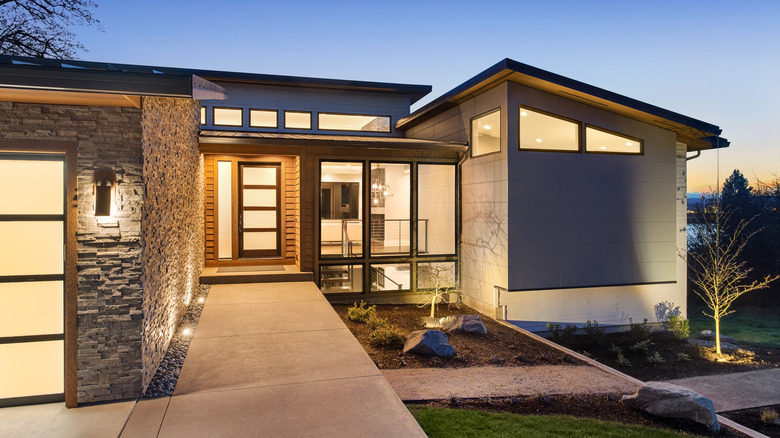The Ultimate Guide To Finding Your Perfect Front Door
The front door of your residence is the focal point for the home's curb appeal. It provides both practical and aesthetic qualities, lending style and functionality to your home's entryway. As stated by US Window & Door, your home's front door makes a first impression on guests as well as passersby. Consequently, the quality and attractiveness of your front entryway reveals a lot about you.
Whether you're building a new home, making renovations on an existing home, or simply sprucing up your home's exterior, it may be time to search for a new front door. As with any shopping project, you'll need to consider several criteria in your research. Important factors include the material, color, durability, style, and energy efficiency of the front door that you select. Choosing the most appropriate material is a good starting point for your project. Brothers Services Company notes that wood, steel, and fiberglass are the primary choices for front doors. Additional considerations to steer your search include whether you want glass panes in the door, sidelights, or an over-door transom window. Of course, choosing a door that complements the architectural style of your house is also an important issue. Finally, you'll need to decide whether you're purchasing a simple door slab or installing a door that is prehung in a new door jamb.
Wood front doors
Painted or stained, a wood front door contributes warmth and beauty to your home's main entrance. Wood exudes a timeless character that welcomes those who enter. According to Brick and Batten, manufacturers use an array of wood types to build exterior doors. These include cedar, oak, bamboo, pine, mahogany, and more. A wooden door lends itself to customization through the addition of glass panels, moldings, and hardware. You can stain and seal the wood to show the beauty of the wood grain. On the other hand, you can paint your front door any color you desire. Wood material provides noise dampening to reduce the distraction of outside sounds as well as energy efficiency to aid in your home's interior climate control.
Feldco points out a few disadvantages of wood front doors. First, wood tends to age more rapidly than either steel or fiberglass materials. It requires regular maintenance such as staining or painting every couple of years. If the front door is exposed to weather elements, the wood may dry out and crack in only a few years. Additionally, a wood front door is susceptible to damage from termites as well as warping and swelling due to high humidity. Ultimately, a wood front door may need to be replaced more quickly than one made from a different material.
Steel front doors
For durability and strength, steel tops the list of desirable materials for your front door. Although builders use steel doors more commonly in public and industrial buildings than in private homes, a steel front door is a good investment for your entryway. In fact, Deavita states that a steel front door may cost less than one made from wood or fiberglass. Steel front doors last for many years, and they do not require the maintenance that wood front doors do. Additionally, steel doors out-perform other materials when it comes to security, heat resistance, and weather resistance. On the other hand, steel is susceptible to rust if scratches are not painted over in a timely manner.
According to Tom Adams, steel doors are not made of solid steel due to the weight of the material. Instead, steel exterior doors feature a 20-to-26-gauge steel coating over a core made of polyurethane or polystyrene. A lower number in the steel coating gauge represents a thicker layer of steel. Even with the plastic interior core, a steel front door may prove to be heavy and unwieldy for a DIYer.
Fiberglass front doors
Fiberglass front doors provide superior weather resistance and energy efficiency when compared with other front door materials. According to ODL, these qualities derive from the construction of fiberglass doors. Manufacturers produce the front and back sides of a fiberglass door via a compression molding process. After placing the two sides on a frame, they fill the interior space with an efficient insulating material. It's this extra insulation that gives fiberglass doors a competitive edge in energy efficiency. However, a fiberglass front door may not be as secure against intruders as a substantial wood or steel front door.
Noted as a durable material, fiberglass does not warp or rot in the way that wood does. Rocky Mountain Windows recommends fiberglass front doors as low-maintenance options that do not require painting, sealing, and repairs. Additionally, pets cannot damage fiberglass with scratches in the way that they can mar the finish on a steel front door.
Aluminum front doors
Aluminum is a viable choice for a front door material due to its durability and rust resistance. Especially in coastal locations with a moist climate and salt air, aluminum may be your best choice for a front door (via Innovative Aluminum and Glass). The metal is treated for weather resistance. It will not rust or corrode in the way that steel does, and it will not warp, rot, or crack in the way that wood does. However, the high cost is a downside, as aluminum front doors may be more expensive than other options.
According to Rustica, an aluminum front door is almost maintenance-free. The non-porous metal surface does not hold onto dirt and grime. You can use a mild detergent and water to remove any dust, pollen, or dirt build-up. An additional benefit for DIYers is that aluminum doors are lightweight when compared with other materials. This is an important advantage during the installation process.
Pre-hung front doors
For new construction as well as for certain replacement scenarios, a pre-hung front door is a wise choice. According to Doors Galore, a pre-hung door consists of a door slab with hinges that attach it to an outer frame. It's an all-in-one unit that is ready to be installed in a rough door opening. Available in a wide range of styles and colors, pre-hung doors offer weather-tight construction and the assurance that the door is hung straight and swings freely. It's an obvious choice for new construction but equally viable for replacing a front door with an old, worn, or damaged frame.
Metrie explains that before you order a pre-hung door, it's important to determine whether you want a right-handed door or a left-handed door. Of course, your front door will swing inward toward the interior of the house, but you'll have a choice of a right-handed or left-handed swing. The door will arrive with pre-drilled holes for the doorknob and locking system, but you'll need to install the hardware. Before placing an order for a pre-hung door, it's wise to consult a professional regarding measurements of your rough door opening, the door jamb, and any special-size door knob or hardware you wish to use.
Front door replacement
If your front door frame is in good shape, you can make a DIY job of simply replacing the door. In this case, you'll replace the door slab within the existing door frame. Brennan states that it's a useful solution as long as the door slab replacement is weathertight and fits the old door frame without any gaps. A door slab may become damaged or cracked through age or accident. However, if the door frame is equally as old and worn as the door slab, you might want to purchase a pre-hung door to replace the entire unit at one time.
If you decide to replace only the door slab, it will arrive without any hardware. This allows you to reuse the hardware from your old front door or purchase a new set. Additionally, you'll need to drill holes for the doorknob and deadbolt as well as chisel out the indentations for the hinges. Ultimately, you'll prepare the new door slab to hang within your door frame in a balanced and tight manner while opening and closing with ease.
Double entry front doors
If the architecture of your home allows it, you might create a gracious and welcoming entryway by installing a double entry front door. RWC asserts that double entry front doors will enhance your home's curb appeal and may lead to increased interest from potential buyers when you're ready to sell the house. Of course, the rough door opening must be large enough to accommodate double entry doors. This type of front door style works best with large homes that feature expansive entryways. Certain building styles such as Victorian and colonial architecture cry out for double entry doors to highlight their aesthetic qualities.
A double entry front door will become a focal point of your home's facade. You can move large furniture into the house with ease. If you use glass panes in the double doors, you can significantly increase the natural light in your foyer. On the other hand, you'll need to spend more money on double entry doors than on a single entry door (via Springfield Overhead Door). The cost of the surrounding architecture added to the cost of the doors may be a consideration in your building or renovation budget.
Front doors with glass sections
Natural light adds to the ambience of a home, increasing feelings of well-being for the occupants. A front door with glass allows daylight into your living space, making it a popular choice for many homeowners. Of course, safety is a consideration. Brennan explains that front doors require safety glass, manufactured via tempering or laminating processes to ensure strength and resistance to breakage. In today's market, numerous customizable options feature glass sections in front doors. Ranging from doors that are almost entirely glass to doors with small windows in their upper sections, homeowners may choose from a wide array of styles.
On the downside, you may sacrifice privacy and security when you choose a front door with glass sections. Anyone will be able to see into your home, and burglars might break the glass to gain entry. Allsaints suggests using tinted or frosted glass to enjoy the infusion of natural light while maintaining your privacy. Additionally, textured options such as granite glass or sandblasted glass may solve the privacy issue.
Front doors with sidelights
You can increase the natural light in your home's interior by installing a front door with sidelights. These are narrow, vertical, non-opening windows located on either side of the door. The sidelights are situated to the outside of the door jamb and within the door frame. They run the full height of the door from bottom to top. Most often, we see left-hand and right-hand sidelights flanking the door symmetrically. Occasionally, homeowners choose to feature a sidelight on only one side of the door. Plastpro explains that adding sidelights to your front door can contribute to your home's curb appeal in a big way. Add sidelights to a door with glass sections or to a solid door. Either way, the sidelights will enhance the home's entryway.
Doors by Decora suggests a plethora of style options for sidelights. Homeowners can customize their choices to match the size and complement the style of any front door. Of course, sidelights detract from your sense of privacy. As with panes in a front door, sidelights may be tinted, frosted, or textured to allow light into the home without sacrificing privacy. Additionally, some sidelight designs preserve a degree of privacy by featuring solid materials in the lower sections with glass panes only in the upper sections.
Front doors with transom windows
When you're building or renovating, keep in mind that you can allow natural light to flow into your home through a transom window above the front door. HPD Consult explains that functioning transom windows in old buildings provided ventilation for the interior rooms. However, most modern transom windows do not open and close. Instead, these fixed windows, spanning the top of a front door header, exist for aesthetic purposes as well as to admit sunlight into the home. If you're considering a front door with a transom window, you'll need to ensure that your home's architecture allows space for installing this feature.
Doors of Excellence points out that a transom window above the front door allows natural light into your home without sacrificing privacy. With a variety of styles available, transom windows may feature ornately curving shapes or straight muntins separating the panes of glass. Although clear glass admits more light, some transom windows feature stained or tinted glass for decorative purposes. Often paired with sidelights, transom windows for front doors contribute elegance to a home's curb appeal.
Energy-efficient front doors
When you're selecting a front door for your home, it's important to keep energy efficiency in mind. The U.S. Department of Energy explains that you'll want to check the energy performance rating of a new front door. The National Fenestration Rating Council (NFRC) provides labels to inform you regarding the solar heat gain coefficient (SHGC) of a new door. On a scale from 0 to 1, a low SHGC rating is desirable in climates that primarily require indoor cooling. On the other hand, a high SHGC rating indicates greater energy efficiency in climates where indoor heating is the main requirement. Additionally, a low U-factor tells you that the door efficiently maintains a warm and cozy indoor temperature during cold weather. While shopping for a front door, you might look for the Energy Star label to find the most energy-efficient door for your home's climate conditions.
Some of the most energy-efficient front doors are constructed with a steel or fiberglass skin over a polyurethane foam insulation core. These types of doors provide significantly greater energy efficiency than wood doors. For additional efficiency, it's important to maintain the caulking and weatherstripping around any exterior door and its frame.
Farmhouse style front doors
There's no denying the immense popularity of farmhouse style in home decor, and a front door in this style might complement your entryway perfectly. A farmhouse front door exudes a friendly, cozy, and inviting vibe. It's reminiscent of the comfort and simplicity of farmhouses in the Americana tradition of bygone centuries. Portella notes that the popularity of farmhouse design is here to stay, and it's not a passing fad or trend. Therefore, a farmhouse-style front door represents a wise investment that can complement your home's architecture for many years to come.
These front doors are typically rendered in wood, often with detailing to show expert craftsmanship. Typical features of farmhouse front doors include beveled panels, vertical slats, and millwork that mimics barn doors. According to Pella, a farmhouse-style front door may be painted any color, or it may be stained and sealed to highlight the beauty of the wood grain. Additionally, many farmhouse front doors feature glass panes separated by wood muntins.
Traditional style front doors
A traditional-style front door exudes a sense of timeless, classic elegance as guests enter your home. According to Plastpro, traditional-style front doors date back to colonial times. During the 18th century, American carpenters built doors to mimic the styles found in England and France. Although wood is a popular material for traditional doors, modern-day fiberglass doors mimic the look of wood while offering better energy efficiency. Variations on traditional-style front doors include double-entry doors, sidelights, arched transom windows, and doors with glass sections.
Trimlite asserts that symmetry is a hallmark of traditional design. Whether stained to play up the wood grain or painted in a soothing color, a traditional front door contributes a sense of peace and harmony to your home's entryway. Additionally, details such as wood trim, beveled panels, and carvings lend an elegant vibe to traditional front doors. Keep in mind that modern door manufacturers can produce fiberglass doors that offer the details of traditional wood trim and millwork. Therefore, you don't need to sacrifice energy efficiency to achieve a traditional look for your front entryway.
Contemporary style front doors
The sleek lines of a contemporary front door may complement your home's modern design, according to New England Building Supply. Rather than featuring ornate trim and panels, contemporary front doors offer simplicity. They feature clean lines and smooth surfaces that fit flush to the door jambs without decorative millwork. Wood, fiberglass, steel, and aluminum are prime materials for contemporary style front doors. Notably, steel front doors may project an industrial feel for a modern-style home.
Frequently rendered in bright, bold colors, contemporary front doors announce an energetic vibe for your home's entryway. On the other hand, many contemporary front doors feature the beauty of wood grain from natural wood or from fiberglass that closely mimics wood. As an additional feature, contemporary front doors may include glass sections, sometimes rendered in interesting and unusual shapes. Avi suggests that multiple, horizontal glass sections contribute a distinctly contemporary feel to an otherwise simple and sleek front door.
As stated previously, your front door is the focal point of your home's facade. In addition to serving utilitarian purposes, it offers you the opportunity to make a positive, personal statement to the outside world. With myriad options available on today's market, you're sure to find a front door that perfectly suits your home's entryway and provides years of functional service.
